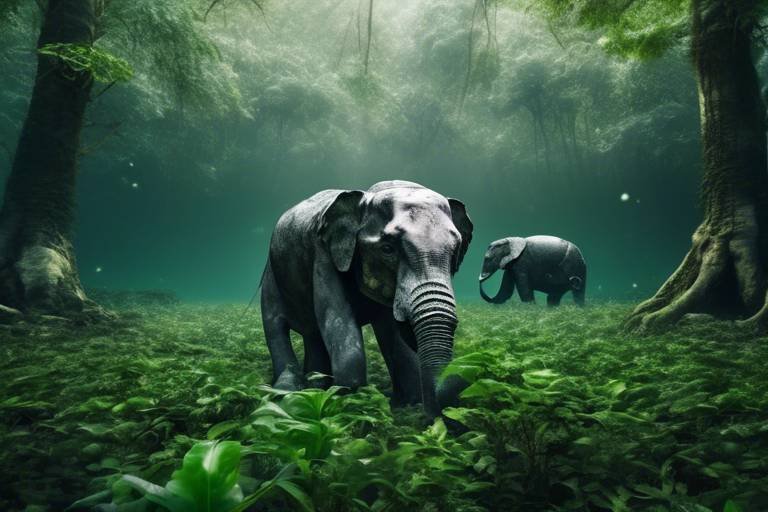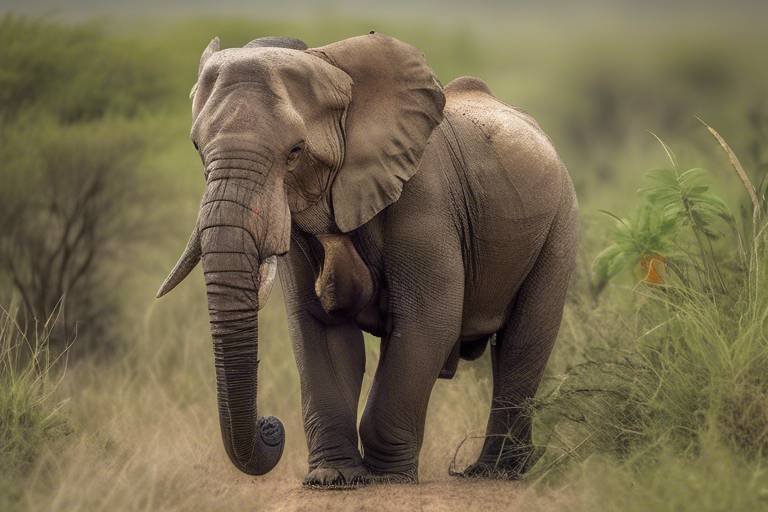The Role of AI in Environmental Conservation
In today's rapidly changing world, the intersection of technology and environmental conservation has never been more critical. Artificial Intelligence (AI) is stepping up as a game changer, transforming how we approach conservation efforts. Imagine having a powerful ally that can analyze vast amounts of data, predict trends, and optimize resource management—all to protect our planet. This article dives deep into the various ways AI is enhancing our conservation strategies, making them more effective and sustainable. It's not just about saving the environment; it's about using cutting-edge technology to ensure a healthier planet for future generations.
AI technologies are fundamentally reshaping conservation strategies, offering innovative solutions to age-old environmental challenges. Traditional methods often fall short due to limited data analysis capabilities and slow response times. With AI, we can tackle these issues head-on. For instance, AI algorithms can process complex datasets much faster than humans can, identifying patterns and insights that would otherwise go unnoticed. This capability enables conservationists to make informed decisions quickly, addressing urgent issues like climate change and biodiversity loss more effectively. Think of AI as a supercharged assistant, helping conservationists navigate through the overwhelming amount of information available today.
One of the most significant advantages of AI in conservation is its ability to enhance data collection and analysis. Imagine trying to piece together a massive puzzle with thousands of tiny pieces—this is what researchers face when gathering environmental data. AI helps streamline this process, allowing for more accurate and efficient data gathering. By leveraging machine learning algorithms, researchers can analyze vast datasets, leading to better-informed conservation decisions. For example, AI can help identify trends in species populations or detect changes in land use with unprecedented precision.
Remote sensing technologies powered by AI are revolutionizing how we monitor ecosystems. These tools provide real-time insights into critical factors like land use changes, deforestation rates, and wildlife movements. This information is crucial for effective conservation planning. Imagine having a bird’s eye view of the entire ecosystem, allowing conservationists to respond swiftly to changes. This level of monitoring was unimaginable just a few years ago, but now it's at our fingertips.
AI's application in analyzing satellite imagery is a prime example of its transformative power. By processing images over time, AI can help track habitat loss and assess the health of ecosystems. This technology allows us to visualize changes that occur over months or years, providing valuable data that can inform conservation strategies. For instance, if a particular forest area shows signs of rapid deforestation, conservationists can mobilize resources to address the issue immediately.
Drones equipped with AI capabilities are another exciting development in conservation technology. These flying devices can survey hard-to-reach areas, enabling conservationists to monitor wildlife populations and assess environmental conditions without disturbing natural habitats. Picture a drone soaring over a dense forest, capturing real-time data on animal movements or vegetation health. This not only saves time but also minimizes human impact on delicate ecosystems.
AI-driven predictive analytics can forecast environmental trends and potential threats. This capability allows conservationists to proactively address issues such as species extinction and habitat degradation. For example, by analyzing historical data and current trends, AI can predict which species are at risk of extinction, giving conservationists the chance to implement protective measures before it's too late. It's like having a crystal ball that helps us foresee and mitigate potential environmental disasters.
AI tools are playing a crucial role in optimizing resource management within conservation efforts. By providing insights into sustainable practices, AI helps improve efficiency in resource allocation and minimizes waste in conservation projects. Imagine a world where every resource is utilized effectively, ensuring that conservation efforts are both impactful and sustainable. This is the future that AI is helping to create.
Water is one of our most precious resources, and AI technologies are essential in managing it effectively. AI can monitor water usage, predict shortages, and implement conservation strategies that ensure sustainable access to clean water. This is particularly important in regions facing water scarcity, where every drop counts. By utilizing AI, we can develop smarter water management systems that not only conserve resources but also support local communities.
AI is also aiding in the development of innovative wildlife protection strategies. By analyzing patterns in animal behavior and human activity, AI can help create effective anti-poaching measures and habitat restoration plans. Imagine a world where technology works hand-in-hand with nature to protect endangered species. With AI, this vision is becoming a reality, as conservationists can now respond more effectively to threats against wildlife.
AI can facilitate community engagement in conservation efforts, providing educational tools and platforms that raise awareness about environmental issues. By involving local populations, we can foster a sense of ownership and responsibility towards conservation. For instance, AI-driven citizen science projects empower individuals to contribute to data collection and monitoring efforts. This not only enriches the data but also strengthens community ties and encourages sustainable practices.
Citizen science projects powered by AI allow everyday people to play a role in environmental conservation. Imagine a smartphone app that enables you to report sightings of endangered species or track pollution levels in your neighborhood. These initiatives not only enhance data collection but also engage communities in meaningful ways, making conservation a shared responsibility.
Moreover, interactive AI platforms enhance environmental education by making learning engaging and accessible. These tools equip communities with the knowledge they need to participate actively in conservation initiatives. Picture a virtual classroom where people can learn about local ecosystems, conservation strategies, and how to implement sustainable practices in their daily lives. This kind of education is vital for fostering a culture of conservation.
- How is AI used in environmental conservation? AI is used in various ways, including data collection and analysis, predictive analytics, resource management, and community engagement.
- What are the benefits of using AI in conservation? AI enhances accuracy, efficiency, and responsiveness in conservation efforts, allowing for better-informed decisions and proactive measures.
- Can AI help in wildlife protection? Yes, AI can analyze patterns in animal behavior and human activity to develop effective wildlife protection strategies.
- How does AI engage local communities in conservation? AI facilitates citizen science initiatives and interactive learning platforms that empower individuals to contribute to and learn about conservation efforts.

Understanding AI's Impact on Conservation
Artificial Intelligence (AI) is not just a buzzword; it is a revolutionary force that is reshaping the landscape of environmental conservation. Imagine a world where technology and nature work hand in hand to combat the pressing challenges posed by climate change and biodiversity loss. AI is making this dream a reality by enhancing traditional conservation methods in ways we never thought possible. From analyzing vast datasets to predicting future environmental trends, AI is proving to be an invaluable ally in the fight to protect our planet.
At its core, AI brings a level of efficiency and precision to conservation efforts that was previously unattainable. For instance, traditional conservation strategies often relied on manual data collection and analysis, which can be time-consuming and prone to human error. In contrast, AI technologies can process large volumes of data at lightning speed, identifying patterns and insights that would take humans weeks or even months to uncover. This capability allows conservationists to make better-informed decisions that can significantly enhance the effectiveness of their initiatives.
Moreover, AI's ability to analyze data from various sources—such as satellite imagery, drones, and environmental sensors—enables a comprehensive understanding of ecosystems. This multifaceted approach means that conservationists can monitor changes in real time, assess the health of habitats, and respond swiftly to emerging threats. For example, AI can detect early signs of deforestation or habitat degradation, allowing for timely interventions that can prevent further damage. The potential for AI to transform conservation strategies is immense, as it equips researchers with tools to tackle environmental challenges with unprecedented accuracy.
One of the most exciting aspects of AI in conservation is its potential for predictive analytics. By analyzing historical data and identifying trends, AI can forecast future environmental changes and threats. This predictive capability allows conservationists to be proactive rather than reactive, addressing issues before they escalate into crises. For instance, predicting species extinction risks or habitat loss can lead to targeted conservation efforts that prioritize the most vulnerable ecosystems and species.
In summary, AI is not just enhancing conservation efforts; it is redefining them. By leveraging advanced technologies, conservationists can gain deeper insights into ecological dynamics, optimize resource management, and engage communities more effectively. The integration of AI into environmental conservation is a game-changer, offering new hope in the battle against climate change and biodiversity loss. As we continue to explore the innovative applications of AI, the future of conservation looks brighter than ever.

Data Collection and Analysis
In the realm of environmental conservation, data is the lifeblood that fuels effective strategies and informed decision-making. With the advent of artificial intelligence (AI), the landscape of data collection and analysis has undergone a remarkable transformation. Imagine a world where researchers can sift through mountains of data in the blink of an eye, uncovering patterns and insights that were once hidden beneath the surface. This is the power of AI, and it is reshaping how we approach conservation efforts.
AI significantly enhances data collection processes, enabling researchers to gather and analyze vast amounts of environmental data with greater accuracy and efficiency. Traditional methods of data collection often involve labor-intensive processes that can be prone to human error. However, AI algorithms can automate these processes, leading to better-informed conservation decisions. For instance, AI can analyze data from various sources, such as climate models, satellite imagery, and sensor networks, to provide a holistic view of environmental health.
One of the most exciting applications of AI in conservation is through remote sensing technologies. These tools allow for real-time monitoring of ecosystems, providing critical insights into land use changes, deforestation rates, and wildlife movements. By leveraging AI, researchers can process data from remote sensors and satellites, enabling them to identify trends and anomalies that might go unnoticed with traditional methods. This capability is crucial for effective conservation planning, as it allows conservationists to respond swiftly to emerging threats.
The utilization of AI in analyzing satellite imagery has revolutionized our ability to track environmental changes over time. By employing machine learning algorithms, researchers can detect subtle shifts in land cover, enabling them to monitor habitat loss and assess the health of ecosystems. For example, AI can be used to classify different land types and identify areas at risk of degradation, providing a roadmap for targeted conservation efforts.
Drones equipped with AI capabilities are another game-changer in the field of conservation. These flying machines can survey hard-to-reach areas, allowing conservationists to monitor wildlife populations and assess environmental conditions without disturbing natural habitats. Imagine being able to capture high-resolution images of endangered species or track their movements across vast landscapes—all thanks to AI-powered drones. This technology not only enhances data collection but also reduces the impact on wildlife, making it a win-win for conservationists.
AI-driven predictive analytics can forecast environmental trends and potential threats, allowing conservationists to proactively address issues such as species extinction and habitat degradation. By analyzing historical data and identifying patterns, AI can help predict future scenarios, enabling conservationists to implement strategies before problems escalate. For instance, if data indicates a decline in a particular species, conservationists can take immediate action to protect its habitat or implement breeding programs to bolster its numbers.
In summary, the integration of AI into data collection and analysis is revolutionizing environmental conservation. With its ability to process vast amounts of data quickly and accurately, AI empowers researchers to make informed decisions that can have a significant impact on the health of our planet. As we continue to face pressing environmental challenges, embracing AI technologies will be crucial in our quest for sustainable solutions.
- How does AI improve data collection in conservation?
AI automates data collection processes, allowing researchers to gather and analyze large datasets quickly and accurately, leading to better conservation strategies. - What role do drones play in conservation?
Drones equipped with AI can survey hard-to-reach areas, monitor wildlife populations, and assess environmental conditions without disturbing natural habitats. - Can AI predict environmental trends?
Yes, AI can analyze historical data to forecast future environmental trends, helping conservationists address potential threats proactively.

Remote Sensing Technologies
Remote sensing technologies, powered by artificial intelligence, are revolutionizing the way we monitor and manage our ecosystems. Imagine having the ability to observe vast landscapes from above, capturing data on everything from deforestation to wildlife movements, all without ever setting foot on the ground. This is not just a dream; it’s a reality made possible through advanced AI algorithms that process and analyze data collected from various sources.
One of the most significant advantages of remote sensing is its ability to provide real-time insights. For instance, AI can analyze satellite imagery to detect changes in land use, assess deforestation rates, and even track the migration patterns of endangered species. This immediate access to data allows conservationists to make informed decisions quickly, adapting their strategies to the ever-changing environmental landscape.
Moreover, the integration of AI with remote sensing technologies enables researchers to gather and process massive amounts of data efficiently. Traditional methods of data collection can be time-consuming and labor-intensive, often leading to delays in critical conservation efforts. However, with AI, the analysis of satellite images and aerial footage can be conducted in a fraction of the time, providing timely insights that can be acted upon swiftly.
To illustrate the impact of remote sensing technologies, consider the following table that outlines key applications:
| Application | Description |
|---|---|
| Deforestation Monitoring | AI analyzes satellite images to identify and quantify deforestation activities over time. |
| Wildlife Tracking | Using drones and AI, researchers can monitor animal movements and behaviors without disturbing their habitats. |
| Habitat Assessment | Remote sensing helps assess the health of ecosystems, identifying areas that require urgent conservation efforts. |
Additionally, drones equipped with AI capabilities are taking remote sensing to new heights—literally! These flying machines can access hard-to-reach areas, capturing high-resolution images and data that were previously impossible to obtain. This technology not only enhances our understanding of wildlife populations but also helps in assessing environmental conditions in challenging terrains.
In conclusion, remote sensing technologies powered by AI are not just enhancing our ability to monitor the environment; they are fundamentally changing the way we approach conservation. By providing real-time data and insights, these technologies empower conservationists to act decisively and effectively, ensuring that we protect our planet for future generations.

Satellite Imagery
Satellite imagery has revolutionized the way we observe and understand our planet. With the integration of artificial intelligence, the analysis of these images has become not only faster but also significantly more accurate. Imagine having a bird's-eye view of the Earth, capturing every detail from sprawling forests to shrinking glaciers. This technology allows conservationists to monitor changes in the environment over time, providing crucial insights into various ecological dynamics.
One of the most remarkable aspects of AI-enhanced satellite imagery is its ability to track habitat loss. By comparing images from different periods, researchers can pinpoint areas where deforestation is occurring at an alarming rate. This is particularly important in regions where biodiversity is at risk, as it allows for timely interventions. For instance, if a satellite detects a sudden increase in logging activities in a previously protected area, conservationists can mobilize resources to address the issue before it escalates.
Furthermore, AI algorithms can analyze satellite data to assess the health of ecosystems. By examining factors such as vegetation cover, soil moisture, and water bodies, scientists can gain insights into the overall vitality of a region. This information is invaluable for conservation planning, as it helps identify which areas require immediate attention and which are thriving. For example, if a satellite image reveals a decline in vegetation health in a specific area, conservationists can investigate the underlying causes, whether it's due to climate change, pollution, or illegal activities.
In addition to monitoring habitat changes, AI-driven satellite imagery plays a crucial role in wildlife conservation. By tracking animal movements and migration patterns, researchers can better understand the habitats that species rely on. This knowledge is essential for creating effective protection strategies. For instance, if a satellite shows a significant decline in a particular species' habitat, conservationists can prioritize efforts to restore that area or create wildlife corridors that allow animals to migrate safely.
Overall, the integration of AI with satellite imagery is a game-changer in the field of environmental conservation. It empowers scientists and conservationists to make data-driven decisions that can significantly impact the preservation of our planet's biodiversity. As we continue to face challenges like climate change and habitat destruction, these technological advancements offer hope and a pathway to a more sustainable future.

Drone Technology
In recent years, has emerged as a game-changer in the field of environmental conservation. Imagine having the ability to soar above the treetops, capturing real-time data without ever setting foot on the ground. Drones, equipped with advanced AI capabilities, allow conservationists to monitor wildlife populations, assess environmental conditions, and conduct research in areas that are often challenging to access. This technology not only enhances efficiency but also minimizes the disturbance to natural habitats, which is crucial for maintaining ecological balance.
One of the standout features of drones is their versatility. They can be outfitted with various sensors and cameras, enabling them to collect a wide range of data. For instance, thermal imaging cameras can detect heat signatures, which is invaluable for tracking elusive species or identifying poaching activities. Additionally, multispectral sensors can assess vegetation health, providing insights into ecosystem vitality. This ability to gather diverse data types makes drones a powerful tool in the conservation toolkit.
Furthermore, drones can cover large areas in a fraction of the time it would take traditional methods. For example, a team of researchers might spend weeks trekking through dense forests to gather data, while a drone can fly over the same area in just a few hours, capturing high-resolution images and data points. This efficiency not only saves time but also significantly reduces costs associated with field research.
To illustrate the impact of drone technology on conservation efforts, consider the following table that outlines some key applications:
| Application | Description | Benefits |
|---|---|---|
| Wildlife Monitoring | Tracking animal movements and populations. | Minimizes human disturbance, provides accurate data. |
| Habitat Assessment | Evaluating the health of ecosystems and vegetation. | Quick data collection, early detection of issues. |
| Anti-Poaching Surveillance | Monitoring protected areas for illegal activities. | Real-time alerts, increased protection of wildlife. |
| Disaster Response | Assessing environmental damage after natural disasters. | Rapid assessment, aiding in recovery efforts. |
Moreover, the integration of drone technology with AI algorithms allows for predictive analysis. This means that drones can not only collect data but also analyze it on the fly, providing conservationists with immediate insights into potential threats or changes in the environment. For instance, by analyzing patterns in wildlife movements, drones can help identify migration routes or areas at risk of poaching, enabling timely interventions.
In essence, drone technology is revolutionizing the way we approach environmental conservation. It offers a unique blend of efficiency, precision, and minimal ecological impact, making it an invaluable asset in the fight against biodiversity loss and climate change. As we continue to harness the power of drones, the possibilities for enhancing conservation efforts are virtually limitless.
- What types of drones are used in conservation? There are various types of drones, including fixed-wing and multirotor drones, each suited for different tasks such as surveying large areas or capturing high-resolution images.
- How do drones help in wildlife conservation? Drones enable conservationists to monitor wildlife populations, track movements, and gather data without disturbing the animals or their habitats.
- Are drones safe for the environment? Yes, when used responsibly, drones can minimize human impact on sensitive ecosystems, allowing for effective monitoring and research.
- Can drones be used for anti-poaching efforts? Absolutely! Drones provide real-time surveillance of protected areas, helping to detect and deter poaching activities.

Predictive Analytics in Conservation
Predictive analytics is a game-changer in the field of environmental conservation. Imagine being able to foresee potential threats to ecosystems before they even occur! With the power of artificial intelligence, conservationists can now analyze vast datasets to identify trends and foresee challenges, enabling them to act proactively rather than reactively. This shift in approach is akin to having a crystal ball that reveals the future of our planet, allowing us to make informed decisions that can alter the course of environmental degradation.
One of the standout features of predictive analytics is its ability to model complex environmental interactions. For instance, by analyzing data on weather patterns, habitat changes, and species behaviors, AI algorithms can predict how these elements influence one another. This holistic view is crucial for understanding the intricate web of life. For example, if a particular species is at risk of extinction due to habitat loss, predictive models can suggest the most effective conservation strategies to mitigate this risk. It's like having a roadmap that guides us toward sustainability while avoiding potential pitfalls.
Moreover, predictive analytics can enhance our understanding of climate change impacts on biodiversity. By utilizing historical data and current trends, AI can forecast how shifting climate conditions might affect various species and ecosystems. This information is invaluable for developing targeted conservation efforts that prioritize the most vulnerable populations. For example, conservationists can focus their resources on areas predicted to experience significant habitat changes, ensuring that interventions are both timely and effective.
In addition to biodiversity, predictive analytics also plays a critical role in managing natural resources. By predicting future resource availability, conservationists can implement strategies that promote sustainability. For instance, AI can analyze water usage patterns and predict shortages, allowing for better planning and conservation measures. This proactive approach can help prevent crises before they escalate, ensuring that both people and wildlife have access to the resources they need.
To illustrate the impact of predictive analytics in conservation, consider the following table that summarizes key applications:
| Application | Description | Benefits |
|---|---|---|
| Species Monitoring | Using AI to track population trends and health | Early detection of declines, targeted conservation efforts |
| Habitat Assessment | Predicting habitat changes due to climate or human activity | Informed planning for habitat restoration |
| Resource Management | Forecasting resource availability (e.g., water, food) | Efficient allocation and sustainable practices |
As we continue to face pressing environmental challenges, the integration of predictive analytics into conservation strategies becomes increasingly essential. The ability to anticipate changes and respond proactively not only enhances the effectiveness of conservation efforts but also fosters a deeper understanding of the interconnectedness of our ecosystems. Ultimately, by leveraging predictive analytics, we can pave the way for a more sustainable future, ensuring that our planet thrives for generations to come.
- What is predictive analytics in conservation?
Predictive analytics in conservation refers to the use of AI and data analysis to forecast environmental trends and potential threats, allowing for proactive conservation strategies.
- How does AI improve conservation efforts?
AI enhances conservation efforts by analyzing large datasets, enabling better decision-making and resource management, and facilitating real-time monitoring of ecosystems.
- Can predictive analytics help prevent species extinction?
Yes, by identifying at-risk species and predicting habitat changes, predictive analytics allows conservationists to implement timely interventions to protect endangered species.
- What role does community engagement play in conservation?
Community engagement is vital for successful conservation, as it fosters awareness and encourages local populations to participate in sustainable practices.

Enhancing Resource Management
In the realm of environmental conservation, resource management is crucial. It’s like being the captain of a ship navigating through treacherous waters; you need to know how to allocate your resources wisely to ensure smooth sailing. With the advent of artificial intelligence, we are witnessing a revolutionary shift in how resources are managed. AI technologies are not just tools; they are game-changers that provide insights and solutions to optimize resource use and minimize waste.
One of the most pressing issues we face today is the management of our water resources. Water scarcity is a growing concern, and AI plays a pivotal role in addressing this challenge. By utilizing advanced algorithms, AI can monitor water usage patterns and predict shortages before they become critical. Imagine having a weather app for your water supply—AI can analyze data on rainfall, usage rates, and even evaporation levels to forecast water availability accurately. This proactive approach allows communities to implement conservation strategies effectively and ensure sustainable access to clean water.
Moreover, AI enhances wildlife protection strategies, which are essential for maintaining biodiversity. By analyzing vast datasets on animal behavior and human activities, AI can identify patterns that indicate potential threats to wildlife. For instance, if certain areas are prone to poaching, AI can alert conservationists in real time, allowing them to take preventive measures. This kind of predictive analysis is akin to having a crystal ball that helps conservationists stay one step ahead of threats, thereby protecting endangered species more effectively.
In addition to wildlife and water management, AI also streamlines the allocation of other natural resources. For example, in forestry management, AI can analyze satellite imagery and drone data to assess forest health and growth rates. This information is invaluable for making informed decisions about logging practices and reforestation efforts. By understanding the dynamics of forest ecosystems, we can ensure that our timber resources are harvested sustainably, preserving these vital habitats for future generations.
To illustrate the impact of AI on resource management, consider the following table that summarizes key benefits:
| Resource Type | AI Application | Benefits |
|---|---|---|
| Water | Usage Monitoring | Predicts shortages, promotes conservation |
| Wildlife | Behavior Analysis | Enhances protection strategies, reduces poaching |
| Forests | Health Assessment | Informs sustainable logging, supports reforestation |
As we delve deeper into the potential of AI in enhancing resource management, it becomes clear that these technologies are not just about efficiency; they are about creating a sustainable future. By leveraging AI, we can make smarter decisions that not only benefit our immediate environment but also contribute to the long-term health of our planet. This shift towards intelligent resource management is not merely a trend; it is a necessity in our fight against climate change and biodiversity loss.
- How does AI help in water management? AI analyzes usage patterns and predicts shortages, allowing for proactive conservation measures.
- Can AI prevent wildlife poaching? Yes, AI identifies patterns in animal behavior and human activity to alert conservationists of potential threats.
- What role does AI play in forestry management? AI assesses forest health and growth rates, aiding in sustainable logging and reforestation efforts.

Water Resource Management
Water is the lifeblood of our planet, and managing it wisely is more crucial than ever, especially as climate change intensifies and populations grow. AI technologies are stepping in to revolutionize how we monitor, allocate, and conserve this precious resource. By leveraging advanced algorithms and data analytics, AI can help us understand water usage patterns, predict shortages, and implement effective conservation strategies. Imagine having a tool that not only alerts you to a leak in real-time but also suggests the most efficient way to fix it—this is the power of AI in water resource management.
One of the most significant advantages of using AI in water management is its ability to analyze vast amounts of data from various sources. These sources can include satellite imagery, weather forecasts, and historical usage statistics. By synthesizing this information, AI can identify trends and anomalies that might go unnoticed by human analysts. For example, if a particular region shows a sudden spike in water usage, AI can help pinpoint the cause—be it a drought or increased agricultural activity—allowing for timely interventions.
Moreover, AI-driven systems can optimize water distribution networks, ensuring that water reaches those who need it most while minimizing waste. These systems can predict demand fluctuations based on factors like weather patterns and population movements. For instance, during a heatwave, AI can anticipate increased water usage in urban areas and adjust supply accordingly, ensuring that everyone has access to clean water. This proactive approach not only helps in conserving water but also enhances the overall efficiency of the distribution system.
To illustrate the impact of AI on water resource management, consider the following table that summarizes some key applications:
| Application | Description | Benefits |
|---|---|---|
| Leak Detection | AI algorithms monitor water networks to identify leaks in real-time. | Reduces water loss and maintenance costs. |
| Demand Forecasting | Predicts water usage patterns based on historical data and environmental factors. | Improves resource allocation and reduces shortages. |
| Water Quality Monitoring | AI analyzes data from sensors to detect contaminants in water supplies. | Ensures public health and safety. |
In addition to these applications, AI can also play a pivotal role in community engagement regarding water conservation. By providing tools that allow individuals to track their water usage and receive personalized tips for reducing consumption, AI fosters a sense of responsibility and awareness. It’s like having a personal coach who nudges you towards better habits, making the journey toward sustainability both engaging and rewarding.
As we move forward, the integration of AI in water resource management will not only help us tackle current challenges but also prepare us for future uncertainties. By embracing these technologies, we can ensure that clean water remains accessible for generations to come, transforming our approach to one of sustainability and efficiency.
- How does AI improve water quality monitoring? AI analyzes sensor data to quickly detect contaminants, ensuring timely responses to water quality issues.
- Can AI predict water shortages? Yes, AI can forecast demand fluctuations based on various factors, allowing for proactive management of water resources.
- What are the benefits of using AI in leak detection? AI enables real-time monitoring, which significantly reduces water loss and maintenance costs.

Wildlife Protection Strategies
In the realm of conservation, have become increasingly sophisticated, thanks to the integration of artificial intelligence (AI). Traditional methods of monitoring and protecting wildlife often fell short due to limited resources and outdated technologies. However, AI is revolutionizing how we approach these challenges, making conservation efforts more effective and efficient.
One of the most notable advancements is the use of AI in analyzing patterns of animal behavior and human activity. By leveraging vast amounts of data collected from various sources, including camera traps and satellite imagery, AI algorithms can identify trends that were previously impossible to detect. For instance, AI can analyze movement patterns of endangered species, allowing conservationists to pinpoint critical habitats that require immediate protection. This data-driven approach not only enhances our understanding of wildlife but also informs targeted conservation actions.
Moreover, AI is instrumental in developing anti-poaching measures. Poaching remains one of the most significant threats to wildlife, particularly in regions where law enforcement resources are scarce. AI systems can analyze data from various sources—such as social media, local reports, and environmental sensors—to predict poaching incidents before they occur. By identifying hotspots where poaching is most likely to happen, conservationists can deploy resources more effectively, increasing the chances of preventing these illegal activities.
Additionally, AI technologies are being utilized to create habitat restoration plans. By evaluating the health of ecosystems and the specific needs of various species, AI can help devise strategies that promote biodiversity. This might include identifying areas for reforestation or creating corridors that connect fragmented habitats, allowing wildlife to thrive. The ability to simulate different scenarios and outcomes through predictive modeling means that conservationists can make informed decisions that align with long-term sustainability goals.
As we embrace these innovative strategies, it’s essential to remember that technology alone cannot solve the complex issues facing wildlife conservation. Community involvement and education are crucial components of successful wildlife protection efforts. By combining the power of AI with grassroots initiatives, we can foster a more holistic approach to conservation that not only protects wildlife but also engages local communities in meaningful ways.
In conclusion, the integration of AI into wildlife protection strategies represents a significant leap forward in our ability to conserve biodiversity. By utilizing data analytics, predictive modeling, and innovative monitoring techniques, we can enhance our efforts to safeguard endangered species and their habitats. The future of conservation lies in the synergy between technology and community engagement, paving the way for a more sustainable coexistence with the natural world.
- How does AI help in wildlife conservation? AI enhances wildlife conservation by analyzing data to identify patterns, predict poaching incidents, and inform habitat restoration efforts.
- What are some examples of AI technologies used in wildlife protection? Examples include predictive analytics, remote sensing, and machine learning algorithms that process data from camera traps and satellite imagery.
- Can AI replace traditional conservation methods? While AI significantly improves conservation efforts, it should complement traditional methods rather than replace them, as community engagement remains vital.
- How can individuals contribute to wildlife protection? Individuals can participate in citizen science initiatives, support conservation organizations, and advocate for policies that protect wildlife and their habitats.

Community Engagement and Education
In today's world, community engagement is more critical than ever, especially when it comes to environmental conservation. The role of artificial intelligence (AI) in this sphere is nothing short of revolutionary. Imagine a world where local communities are not just passive observers but active participants in the conservation of their environments. AI facilitates this by providing innovative educational tools and platforms that raise awareness about pressing environmental issues. By harnessing the power of technology, we can inspire individuals to adopt sustainable practices and foster a deeper connection with nature.
One of the most exciting developments in this area is the rise of citizen science initiatives. These projects empower individuals to take part in data collection and monitoring efforts. For instance, AI can analyze data submitted by community members, allowing for real-time insights into local environmental conditions. This participation not only enhances the quality of data collected but also cultivates a sense of ownership and responsibility among community members. When people see their contributions making a tangible difference, it ignites a passion for conservation that can ripple through entire communities.
Moreover, interactive learning platforms powered by AI are transforming the way we educate communities about environmental issues. These platforms offer engaging content that makes learning accessible and enjoyable. Picture an online portal where users can explore interactive maps showing local biodiversity, watch videos on sustainable practices, or even participate in virtual workshops. By integrating gamification and personalized learning experiences, AI-driven platforms can captivate audiences and motivate them to take action.
To illustrate the impact of these initiatives, consider the following table that highlights the benefits of community engagement in conservation:
| Benefit | Description |
|---|---|
| Increased Awareness | Community engagement raises awareness about local environmental issues, leading to informed decision-making. |
| Data Collection | Local residents contribute valuable data, enhancing research quality and depth. |
| Empowerment | Individuals feel empowered by their contributions, fostering a sense of responsibility towards the environment. |
| Collaboration | Engagement encourages collaboration among community members, NGOs, and government agencies. |
In addition to these benefits, AI can also facilitate the development of educational programs tailored to specific community needs. For example, a rural community facing water scarcity could benefit from targeted workshops on water conservation techniques, powered by AI analytics that identify their unique challenges. This kind of personalized education ensures that communities are not only informed but also equipped with the tools they need to implement sustainable practices effectively.
Ultimately, the integration of AI in community engagement and education creates a powerful synergy that can drive significant change. When people are educated, empowered, and engaged, they become champions of conservation, working together to protect their local environments. This collaborative approach is essential for tackling the multifaceted challenges posed by climate change and biodiversity loss.
- What is community engagement in environmental conservation? Community engagement involves actively involving local populations in conservation efforts, encouraging them to participate in decision-making and data collection.
- How does AI enhance community engagement? AI provides tools and platforms that facilitate data collection, education, and communication, making it easier for communities to engage in conservation efforts.
- What are citizen science initiatives? Citizen science initiatives are projects that involve the public in scientific research, allowing them to contribute data and observations that aid conservation efforts.
- Why is education important for conservation? Education equips individuals with the knowledge and skills needed to make informed decisions and adopt sustainable practices, fostering a culture of conservation.

Citizen Science Initiatives
Citizen science initiatives are revolutionizing the way we approach environmental conservation by actively involving the public in scientific research and data collection. Imagine a world where everyday individuals, equipped with smartphones and a passion for nature, contribute to significant conservation efforts. This is not just a dream; it’s a reality that is gaining momentum thanks to the integration of artificial intelligence (AI) in these initiatives. By harnessing the power of AI, these programs not only enhance data accuracy but also empower communities to take ownership of their local environments.
One of the most exciting aspects of citizen science is its ability to democratize scientific research. Traditionally, conservation efforts were often left to experts and organizations with the necessary resources. However, AI-driven platforms are making it easier for anyone with an interest in nature to participate. For instance, through mobile applications, citizens can report sightings of local wildlife, track changes in plant growth, or even document pollution levels in their neighborhoods. This grassroots approach to data collection not only enriches the information available to researchers but also fosters a deeper connection between individuals and their local ecosystems.
Moreover, AI technology plays a crucial role in analyzing the vast amounts of data collected by citizen scientists. With machine learning algorithms, researchers can process this data more efficiently than ever before. For example, AI can help identify patterns in species distribution or detect anomalies in environmental conditions that might indicate a problem. This means that the contributions of citizen scientists are not just valuable; they are essential for making informed decisions about conservation strategies.
To illustrate the impact of citizen science initiatives, consider the following examples:
- Birdwatching Apps: Platforms like eBird allow users to log bird sightings, contributing to a global database that helps researchers monitor bird populations and migration patterns.
- Water Quality Monitoring: Projects like Water Rangers enable citizens to test and report on local water quality, providing crucial data for managing freshwater resources.
- Invasive Species Tracking: Apps such as iNaturalist empower users to document and report invasive species, helping conservationists develop effective management strategies.
These examples highlight how citizen science can lead to tangible outcomes in conservation efforts. By engaging the community, these initiatives not only gather critical data but also raise awareness about environmental issues. Participants often become advocates for sustainability and conservation in their own right, influencing others to take action.
In addition to collecting data, citizen science initiatives also serve as powerful educational tools. They provide a platform for learning about local biodiversity, ecosystems, and the challenges they face. As individuals participate in these projects, they gain valuable insights into scientific methods and environmental stewardship. This knowledge can inspire future generations to continue the fight for conservation.
As we look towards the future, the potential for citizen science initiatives to contribute to environmental conservation is immense. With AI technology continually evolving, the possibilities for data collection and analysis are expanding. By harnessing the power of the community and technology, we can create a more sustainable future for our planet. In essence, citizen science is not just about collecting data; it’s about building a community of informed and engaged individuals who are passionate about protecting our environment.
1. What is citizen science?
Citizen science involves public participation in scientific research, allowing individuals to contribute to data collection and analysis, often through user-friendly platforms and applications.
2. How does AI enhance citizen science initiatives?
AI enhances citizen science by improving data analysis, identifying patterns, and processing large volumes of information quickly, making the contributions of citizen scientists even more impactful.
3. Can anyone participate in citizen science projects?
Absolutely! Citizen science is open to everyone, regardless of their background or expertise. All you need is a willingness to learn and engage with your local environment.
4. What are some examples of citizen science projects?
Examples include birdwatching apps like eBird, water quality monitoring through Water Rangers, and invasive species tracking with iNaturalist.
5. How do citizen science initiatives benefit the environment?
These initiatives help gather critical data for conservation efforts, raise awareness about environmental issues, and foster a sense of community and responsibility towards nature.

Interactive Learning Platforms
In today's digital age, interactive learning platforms are revolutionizing the way we approach environmental education. These platforms leverage the power of artificial intelligence to create engaging and immersive learning experiences that captivate users and foster a deeper understanding of conservation issues. Imagine stepping into a virtual world where you can explore ecosystems, track wildlife, and even simulate conservation strategies. This is not just a dream; it's a reality made possible by AI!
One of the most exciting aspects of these platforms is their ability to tailor content to individual learning styles. For instance, some users may prefer visual aids, while others might benefit from hands-on activities. AI algorithms analyze user interactions and adapt the content accordingly, ensuring that everyone can find a way to engage with the material. This personalized approach not only enhances learning outcomes but also encourages users to take an active role in conservation efforts.
Moreover, these platforms often incorporate gamification elements, making learning feel more like a fun adventure rather than a chore. Users can earn points, unlock achievements, and even compete with friends in challenges that promote awareness about environmental issues. By transforming education into an interactive game, these platforms motivate individuals to learn more about sustainability, biodiversity, and the importance of protecting our planet.
Furthermore, interactive learning platforms serve as a bridge between knowledge and action. They provide users with practical tools and resources to implement what they've learned in their communities. For example, a platform might offer a step-by-step guide on how to start a local recycling program or tips on reducing water consumption at home. This kind of actionable information empowers individuals to make a tangible difference in their surroundings.
To illustrate the impact of interactive learning platforms, let's take a look at a few notable examples:
| Platform Name | Description | Features |
|---|---|---|
| EcoExplorer | An immersive virtual reality experience that allows users to explore various ecosystems. | 360-degree environments, wildlife tracking simulations, interactive quizzes. |
| GreenQuest | A gamified platform focusing on sustainable practices and community projects. | Point system, community challenges, resource-sharing tools. |
| ConserveNow | A mobile app that educates users on conservation strategies through interactive content. | Personalized learning paths, action-oriented tasks, local conservation resources. |
In conclusion, interactive learning platforms are not just tools for education; they are powerful catalysts for change. By making learning engaging, personalized, and actionable, they inspire individuals to take ownership of their role in conservation. As more people become aware of environmental issues and the steps they can take to address them, we move closer to a sustainable future. So, why not dive into one of these platforms and start your journey toward becoming an environmental champion today?
- What are interactive learning platforms? - These are digital tools that use technology, including AI, to create engaging educational experiences focused on various subjects, including environmental conservation.
- How do AI and gamification enhance learning? - AI personalizes the learning experience, while gamification makes it more engaging and fun, encouraging users to participate actively.
- Can I use these platforms for community projects? - Absolutely! Many platforms provide resources and guidance for implementing conservation initiatives in your community.
Frequently Asked Questions
- How is AI used in environmental conservation?
AI is revolutionizing environmental conservation by enhancing data collection and analysis, improving resource management, and fostering sustainable practices. It allows for real-time monitoring of ecosystems, predictive analytics for forecasting environmental trends, and innovative wildlife protection strategies.
- What role does remote sensing play in conservation efforts?
Remote sensing powered by AI enables conservationists to monitor land use changes, deforestation rates, and wildlife movements. This technology provides crucial insights that help in effective conservation planning and decision-making.
- Can AI help in predicting environmental threats?
Absolutely! AI-driven predictive analytics can forecast potential threats like species extinction and habitat degradation. By analyzing patterns and trends, conservationists can take proactive measures to mitigate these risks.
- How does AI improve resource management in conservation?
AI tools optimize resource management by providing insights into sustainable practices, improving efficiency in resource allocation, and minimizing waste. This ensures that conservation projects are both effective and sustainable.
- What is the importance of community engagement in conservation?
Community engagement is vital in conservation as it fosters a sense of ownership and responsibility among local populations. AI can facilitate this by providing educational tools and platforms that raise awareness about environmental issues.
- How can individuals participate in citizen science initiatives?
Individuals can contribute to citizen science initiatives by participating in AI-driven projects that involve data collection and monitoring. This empowers them to play an active role in environmental conservation efforts.
- What are interactive learning platforms in environmental education?
Interactive learning platforms powered by AI make environmental education engaging and accessible. They equip communities with the knowledge and skills needed to actively participate in conservation initiatives, promoting sustainable practices.



















